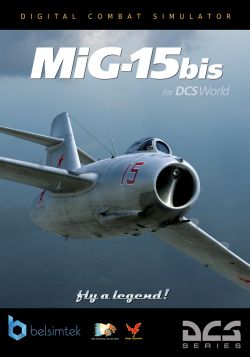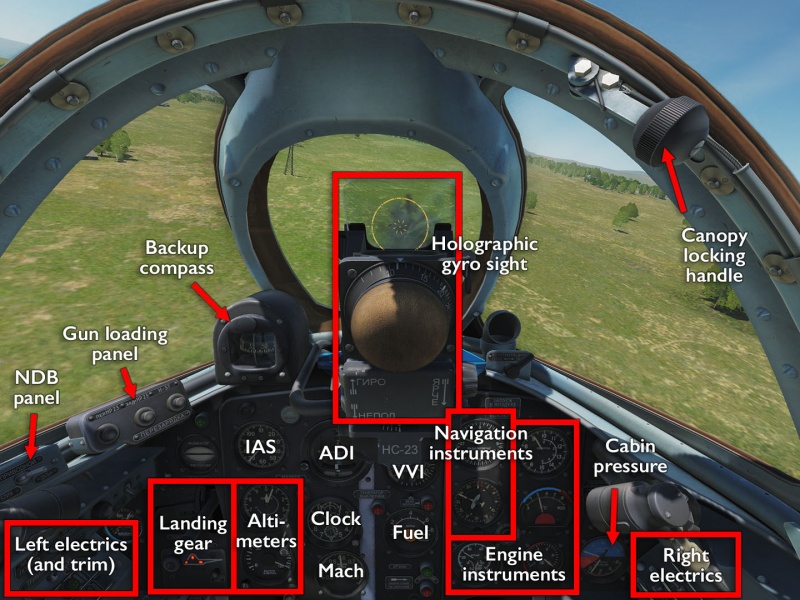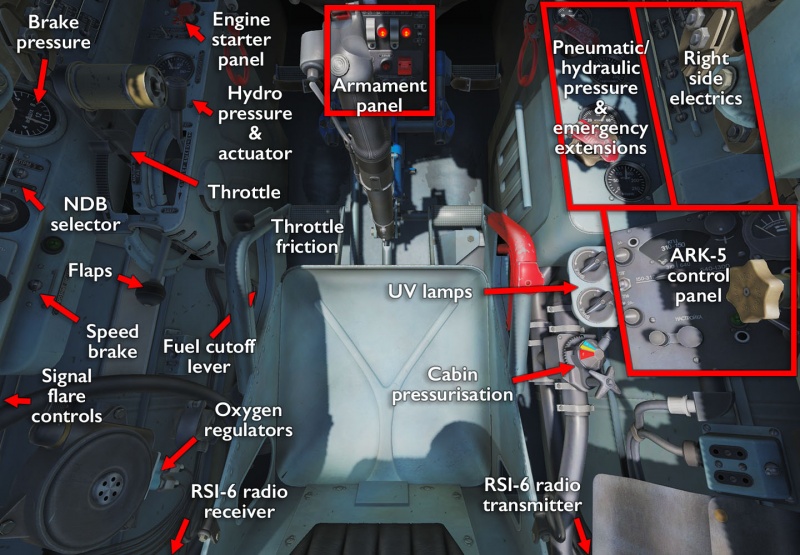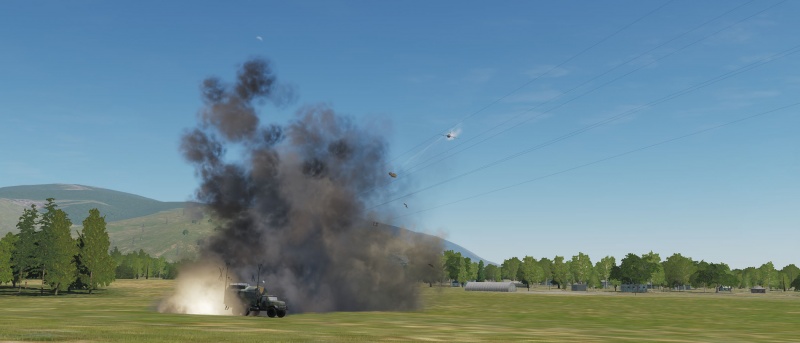MiG-15bis
The end of WWII, two radical new technologies entered warfare: nuclear weapons and jet engines. The threat of the former, carried by the B-29 long-range strategic bomber, mean that the latter had to be used to create a countermeasure. The MiG-15 was that countermeasure, and it turned out to be a very lethal threat to pretty much anything in the air at the time. It came as a nasty surprise in the skies over Korea and had no viable counter of its own until the introduction of the F-86.
Much like the same-era F-86F, the DCS World version of the MiG-15bis sits in a strange place between the earlier, almost completely mechanical and manual WWII prop fighters, and the systems-heavy and highly automated modern jet fighters. Between the two, the F-86F leans more towards the future, with its early missiles, automated sight, and bombing modes, whereas the MiG-15bis leans more towards the past, with its still rudimentary ground controls and its reliance on simple guns and bombs.
Features
Much like the F-86F, the leap forward the MiG-15bis represents needs to be measured against the WWII prop planes that preceded it, not with anything that followed afterwards (including the F-86F). Many of these advanced features are similar to what would soon be found in the Sabre, and for similar reasons:
- Speed brakes(!) to get (or stay) out of the high compressibility state when the flight controls no longer work properly.
- Stageless flaps for even more speed and lift control.
- A tricycle landing gear (but still differential braking rather than proper nose-wheel steering or toe brakes).
- A 37mm cannon to burst B-29:s (and a pair of 23mm cannons for smaller targets).
- A very… curious split radio system that uses (anything but) easily remembered “wave numbers” rather than imperialist pigdog frequencies (1 wave number = 0.025 MHz).
- ARK-5 NDB navigation.
- A whimsical attitude to instrument placement.
Flying the MiG-15bis
The MiG-15bis was built to quickly climb to and catch up with strategic bombers as they came near to, or crossed over, the Soviet borders. Even so, it was not a Mach-capable aircraft — it did not need to be — nor a nimble dive bomber. Its early swept-wing design and jet engine were respectively vulnerable to compressibility issues at higher speeds leading to loss of effectiveness in the controls, and to compressors stalls if flown at high angles of attack or asked to quickly jump between different power levels. The inclusion of speed brakes were a necessity for both: to slow the aircraft down so the controls regained their effectiveness, and so that yanking the throttle back and forth was not the only way of losing or gaining speed — instead, high RPMs (or dive angles) can be maintained while still not picking up unwanted speed.
Both of these problems are shared with the F-86F — the MiG-15bis just suffers from them earlier, and therefore prefers to strike quickly and climb up to safety where the Sabre does not perform as well. At the other end of the spectrum, the MiG-15 also really dislikes low speed — it gets awfully wobbly when you slow down even a little, and requires quite a bit of time (and consequently altitude) to get out of that low-speed state due to its slow-responding engine. Be careful not to underspeed during landings, because it is the worst combination of circumstances to get out of.
Cockpit overview
Getting into the air
Starting the MiG-15bis is not really a complicated process, but it is made a bit unintuitive due to how key instruments and controls are scattered and hidden around the cockpit, and due to the fact that it does not start with turning on the onboard batteries. Indeed, doing so has a fair to even chance of killing the batteries outright and grounding the sortie. Instead:
- Ensure that the battery switch (on the right panel) is off.
- Turn the generator on and request that ground power be connected.
- Turn on all circuit breakers on the right, still excluding the battery switch.
- Turn on all circuit breakers on the left, excluding the isolation valve (on the upper right of the panel) to turn fuel and engine power on.
- Move the throttle to idle, and while in that area, check that the hydro-booster lever is fully forward.
- Uncover and press the engine start button on the throttle.
- Dig down near the floor on the left side of the seat to find the fuel shut-off valve and half-open it as the engine RPM reaches 600; open fully at roughly 1000 RPM.
- Idle the engine at ~2500 RPM to make sure everything is stable, then run it up to 5000 RPM.
- The generator should kick in, its light extinguish, and now we can finally turn off ground power and turn on the on-board battery.
- Close the canopy, turn on the oxygen and cockpit pressurisation valves, and unlock the landing gear.
- Good luck finding the pitot heating switch (it's on the right, next to the voltmeter).
Now it is just a matter of taxiing, which means getting to terms with the rudder+brake lever style of differential braking — a system similar to what you will find in the L-39, MiG-21, Yak-52 and Spitfire.
Shooting something
With as limited as the MiG-15bis' weapon systems are, getting them ready is pretty easy.
- Load the guns by detonating the pyro charges controlled using the box sitting at the front left of the cockpit frame — the guns armed lights should go on.
- Make sure the gunsight is powered (the next lowest row of CB:s on the right).
- Set the expected target wingspan (11m for an F-86F).
- Keep the sight gyro caged until you have found a target; uncage it as you begin your attack.
- Flip open the stick cover to take gun safety off.
- Use the throttle twist handle to adjust range.
- Aim, fire, and remember that the two cannons have very different arcs and ballistics.
Links and files
- Vehicle Size Chart for sight adjustments.
- Chuck's MiG-15bis guide at Mudspike.
- DCS: MiG-15bis by Belsimtek in the DCS shop.
Related DCS modules
- The Museum Relic Campaign by Apache600 (works with either one of the F-86F and MiG-15 modules).
More information
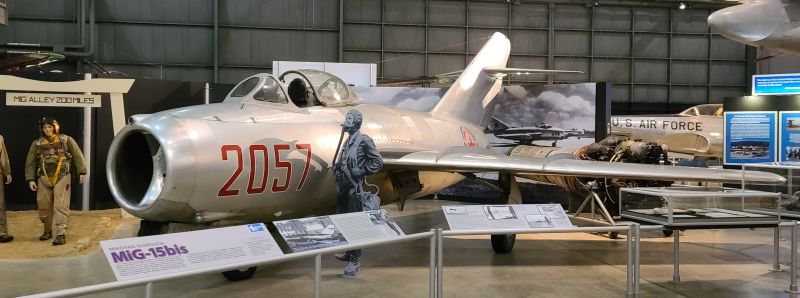
- Mikoyan-Gurevich MiG-15 on wikpedia.
- MiG-15 FAGOT on globalsecurity.org
- Bunyap's Test Flight - DCS: MiG-15 bis Fagot video series.



